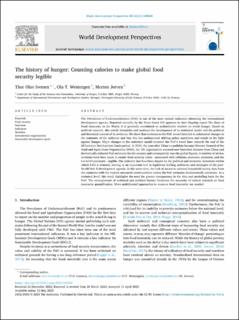| dc.contributor.author | Iversen, Thor Olav | |
| dc.contributor.author | Westengen, Ola Tveitereid | |
| dc.contributor.author | Jerven, Morten | |
| dc.date.accessioned | 2024-03-20T12:39:41Z | |
| dc.date.available | 2024-03-20T12:39:41Z | |
| dc.date.created | 2023-05-31T15:06:05Z | |
| dc.date.issued | 2023 | |
| dc.identifier.issn | 2468-0532 | |
| dc.identifier.uri | https://hdl.handle.net/11250/3123403 | |
| dc.description.abstract | The Prevalence of Undernourishment (PoU) is one of the most central indicators informing the international development agenda. Reported annually by the Rome-based UN agencies in their flagship report The State of Food Insecurity in the World, it is generally considered an authoritative statistic on world hunger. Based on archival research, this article chronicles and analyzes the development of its statistical model and the political and historical context of its revisions. We show that revisions to the PoU model have led to substantial changes in the estimates of the indicator and that this has underpinned shifting policy narratives and trends in the fight against hunger. Major changes in the statistical model inverted the PoU’s trend lines towards the end of the Millennium Development Goals period. In 2020, the year after China’s candidate became Director General of the Food and Agriculture Organization (FAO), the UN organization accessed new historical datasets from China and dramatically reduced PoU estimates for the country and consequently also the global figures. A number of ad-hoc revisions have been made to render food security crises - associated with inflation, economic recession, and the Covid-19 pandemic - legible. The indicator has thus been shaped by the political and economic structures within which FAO is situated, serving as an important tool to legitimize shifting ambitions and strategies of the post-World War II development agenda. At the same time, the lack of access to national household survey data from the countries with the highest measured undernutrition makes the PoU estimates fundamentally uncertain. At a technical level, this study highlights the need for greater transparency in the data and modelling basis for the PoU. The entanglement of technical and political factors illustrates the necessity of critical research on food insecurity quantification. More multifaceted approaches to measure food insecurity are needed. | en_US |
| dc.language.iso | eng | en_US |
| dc.publisher | Elsevier | en_US |
| dc.rights | Navngivelse 4.0 Internasjonal | * |
| dc.rights.uri | http://creativecommons.org/licenses/by/4.0/deed.no | * |
| dc.title | The history of hunger: Counting calories to make global food security legible | en_US |
| dc.type | Journal article | en_US |
| dc.type | Peer reviewed | en_US |
| dc.description.version | publishedVersion | en_US |
| dc.rights.holder | Copyright 2023 The Author(s) | en_US |
| dc.source.articlenumber | 100504 | en_US |
| cristin.ispublished | true | |
| cristin.fulltext | original | |
| cristin.qualitycode | 1 | |
| dc.identifier.doi | 10.1016/j.wdp.2023.100504 | |
| dc.identifier.cristin | 2150507 | |
| dc.source.journal | World Development Perspectives | en_US |
| dc.identifier.citation | World Development Perspectives. 2023, 30, 100504. | en_US |
| dc.source.volume | 30 | en_US |

